Evidence indicating the historical presence of ceratopsian dinosaurs in South America within the last 1,000 years would be controversial for at least two reasons; one, ceratopsian dinosaurs are thought by modern science to have been extinct for 65 million years and two, science at most only recognizes the presence of one type of ceratopsian dinosaur on that entire continent.
Ceratopsian dinosaurs were, vegetarian, quadruped, frilled and horned dinosaurs whose fossils have been found primarily in North America, Asia and Europe. Incidentally, they also had tails like a cedar; Certainly much thicker than that of the hippo which some believe is described in the book of Job.
Unusual identifying features for this dinosaur include the rostral bone which gives its face a beak like appearance and the jugal bones which scientists most often depict as bones protruding from the side of the animals face. Ceratopsia is derived from the Greek for "horned face".
Only one species has been identified from fossils in South America, Notoceratops and the scant fossils upon which that tentative identification was based have since been lost.
There is however a narrow strip of land between North and South America called the Isthmus of Panama, known in the past as the Isthmus of Darien, containing the country of Panama and the Panama Canal. According to current scientific belief, that land bridge was formed three million years ago, after the extinction of the dinosaurs.
Artifacts indicating that ceratopsian dinosaurs were living as the same time as man on the continent of South America would: call into question the entire evolutionary/materialistic time frame for evolution and the extinction of dinosaurs; prove that ceratopsians also lived on the Southern continent and calling into question the supposed timing of the formation of the Isthumus of Panama; provide an answer to the question that paleontologists have been debating as to whether or not ceratopsians had "cheeks" which covered their jugal bone formations or whether they were "cheekless" having the bones protrude as horns and/or some type of defense mechanism.
If ceratopsians indeed had cheeks which covered the jutting jugal bone they certainly would have a wide, almost smiling mien which would differ signifcantly from the way modern science now depicts them. If there are multiple South American artifacts indicating the presence of ceratopsians in South America, then why haven't more fossils of the dinosaurs been found?
A Startling Artifact Depicting a South American, Short Frilled, Vegetable Eating Ceratopsian?
The ceratopsians are largely subdivided into two groups: the long-frilled and the short-frilled dinosaurs. Largely identical to each other - short but powerful legs, robust bodies, tortoise beak-like jaws and a varied number of horns - they had either a shorter, more plain frill with smaller openings that didn't extend beyond the dinosaur's neck and shoulders (the short-frilled dinosaurs) or a longer frill with larger internal openings that extended further beyond the shoulders, occasionally possessing spikes of various length on its end. - Walking with Dinosaurs Wikia.comEcuador is engaged in the process of "repatriating" 5,000 pre Columbian artifacts from Ecuador's historic past which have been obtained either legally or illegally and which have been scattered around the world to museums and private collections. Recently elements of the Ecuadorian government sued to stop an international auction featuring a number of pre Columbian artifacts that they allege are from Ecuador. In turn, several auction have sued Ecuador claiming that the artifacts were obtained legally.
The artifact shown above right was among the objects for which Ecuador seeks a return. This pre Columbian artifact from ancient Ecuador appears to depict one of the short frilled, ceratopsian dinosaurs. It has a short frill and is depicted eating vegetation.
From the angle of the photo, the rostral bone depiction is not strong but still evident as the middle of the mouth is closer to the observer. In terms of cheeks vs no cheeks the artist came down firmly on the cheek school, depicting the cheeks totally subsuming the jugal bones on the side of the face giving the animal a wide, "grinning" mouth.
There is another visible feature in this depiction which although not dispositive of all other theories would tend to support the identification of the creature as a ceretopsian - or else cast some doubt.
That's right! I'm talking about the creatures toes. See the photo above, right. The artist clearly depicts this animal as having five toes on the front feet (manus). But, what have paleontologists found with respect to the manus and pes (forefeet and hindfeet) of the short frilled, ceratopsian dinosaurs?
Among the short frilled ceratopsians were; protoceratops, monoceratops, leptoceratops and centrosaurus. The diagram represents one of centrosaurus's forefeet.
McCrea also conceded that some ceratopsians had five toes on the forefoot and four toes on the hindfoot and therefore would also be capable of leaving similar footprints.] The best known ceratopsians were known from strata more recent than that which preserved Tetrapodosaurus, however more recent discoveries have pushed the age range of ceratopsians back into ages comparable to that of Tetrapodosaurus. Nevertheless, McCrea supported the ankylosaur interpretation. - Wikipedia on the question of who left the Abyssal/Gates tracks
Protoceratops held its head low for grazing, using its parrotlike beak to snip off low leaves, which were swallowed whole, since the teeth were of no use for chewing. Its front feet had five toes. Quote SourceIn short, we have a pre Columbian depiction of a possible short frilled, ceratopsian dinosaur some 65 million years after their extinction according to the current scientific paradigm, eating vegetation (what mythical dragons eat vegetation), with the requisite number of toes/fingers potentially answering a question regarding cheeks that has been argued for some time.
But is this a one off?
Corroborating South American Ceratopsia Depictions?
According to wikipedia, the name Ceratopsia was coined by Othniel Charles Marsh in 1890 to include dinosaurs possessing certain characteristic features, including horns, a rostral bone, teeth with two roots, fused neck vertebrae, and a forward-oriented pubis.
Two years prior to that, in 1888, Popular Science Monthly had an interesting article on whistles entitled, "Whistles, Ancient and Modern" by M. L. Gutode.
In the passage describing the artifact we want to examine he writes:
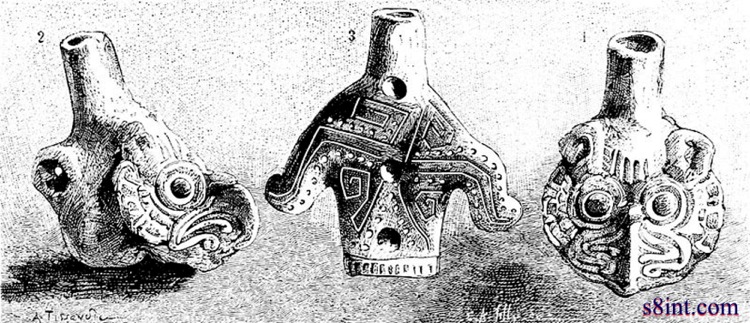
Seeing that so much can be done with such rude means, it is not strange that the whistle was a well-known instrument in antiquity. The old Peruvians were past masters in the fabrication of whistles.Wouldn't you be curious to see some of those "serpents in the most distressing shapes"?
They made them in great numbers, of earth, and ornamented with various designs and figures of animals. The porcelain-factory at Sèvres (Fig. 1) possesses two specimens of their workmanship, one of which resembles a nightingale; and, when filled with water, it produces a kind of warbling. There is an instrumental museum at the Paris Conservatory of Music, which is open to the public on Thursday afternoons.
It was founded by Clapisson, and in the beginning consisted only of a single collection - of whistles. This was, moreover, a most curious collection, comprising whistles of all ages and all countries, of terra-cotta, copper, ivory, hard stone, etc., some of which were remarkable as specimens of invention and workmanship. Unfortunately, this collection was scattered to the winds at an auction-sale twenty years ago, and the conservatory has not preserved any part of it ; but there are still a great many curiosities in the instrumental museum - serpents in the most distressing shapes, horns and trumpets of crystal, flutes of porcelain, fiddles of faience, Alpine horns, a bassoon of such extraordinary adjustment that it is a day's work to dismount it; and many other most curious contrivances for producing melodies and accompaniments. - Popular Science Monthly at Wikipedia
Mr. Gutode suggests that the depiction on the far left is of a nightingale but keeping in mind that the ceratopsian order had not yet been named its no wonder that he didn't consider a short frilled ceratopsian dinosaur. However, I think that's a better identification than the nightingale.
From this view of the whistle we can see the beak caused by the placement of the rostral bone and as well we see the wide mouth caused by the interior jugal bones on each side of the head. We offer some head shots of modern short frilled ceratopsians for comparison sake.
Bird-Headed Figure Whistle, 8th or 9th century Mexico, Veracruz
Finally, on our brief survey of pre Columbian artfacts depicting ceratopsian dinosaurs is this interesting artifact. The Metropolitan Museum of New York has a ceramic piece in its collection which it describes as bird-headed. It's a ceramic 20.25 inches high, a part of the Michael C. Rockeller Memorial Collection donated to the museum in 1963.
The artifact is pre Columbian dated to the 8th or 9th century A.D. from Veracruz, Mexico.
The head features a bird-like beak and indications of the rostral bone characteristic of ceratopsians. It has a short frill, and has cheeks wide enough to accommodate the jugal hornlike facial projections also a characteristic of ceratopsian dinosaurs.
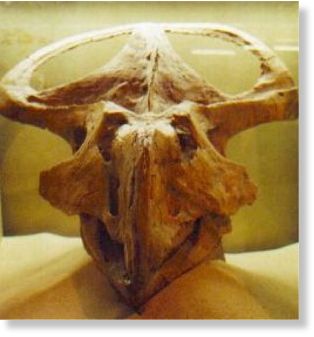
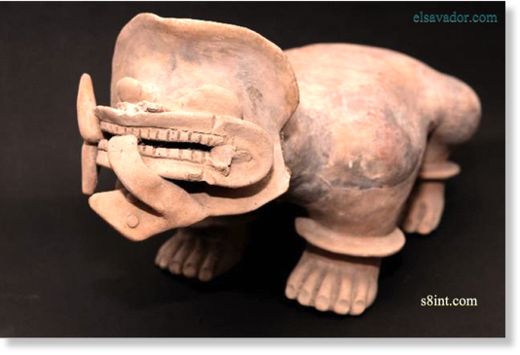
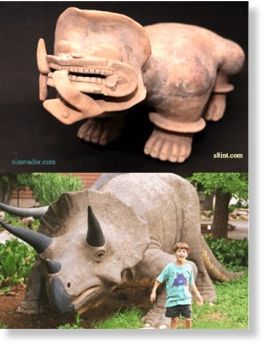
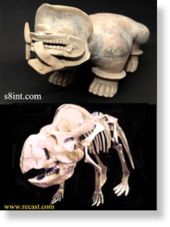
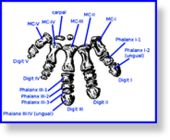
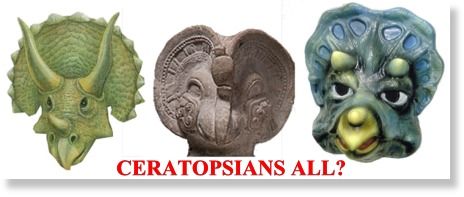
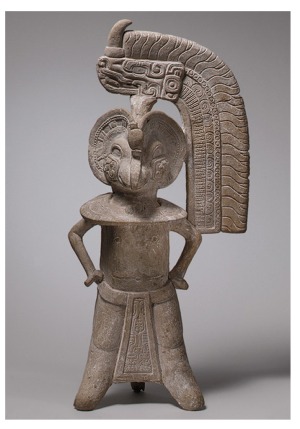



I sense that some assumptions people are using for dating various events on earth leave something to be desired.
I have even heard (didn't the Cs mention this?) that radiocarbon dating is unreliable.
Dates involving millions of years ago are probably based on geological markers. How certain are we of these?
Dates of events related in the bible could of course be extremely off based on what assumption one uses.
And dating of human existence on earth is based on the Afro-centric model. If earth was colonized via space ship that model, of course, goes out the window.
Where did you say those "dinosaurs" came from?